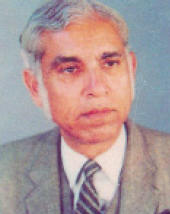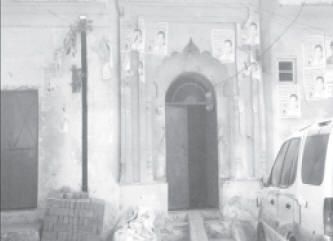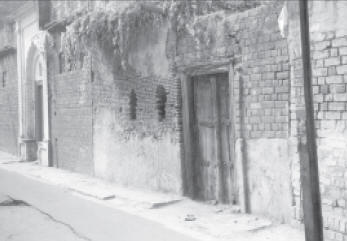Pandit Rameshwar Nath Kao
The Czar of India's
Counter Intelligence
by Dr. B.N. Sharga
 In modern times, a well organised intelligence net
work is a must for any
country
for maintaining its
internal security
and for properly
protecting it from
foreign aggression. It
is now considered as
the back bone of the
administration to
maintain proper law
and order. The
intelligence
inputs help
the government of
the day to take effective
measures in time
for maintaining
peace and communal
harmony. Even in medieval
times, kings
and emperors used to
employ the spies for
getting the correct
information
about the
happenings in their
respective kingdoms and
empires.
So for running any
administration
smoothly and effectively,
we must have a good
intelligence
setup which acts as its
eyes and ears. After the
massive
Chinese aggression in
1962, a
need was felt to have an
agency
to gather foreign
intelligence so
that our nation should not
be
caught unawares in future
about
any such misadventure by
our
neighbouring countries.
The
man who gave a concrete
shape
to this idea with solid
foundation
was Pt. Rameshwar Nath
Kao, popularly known as
Ramji
among his friends and
colleagues.
He not only organised
a vast intelligence
network for
gathering foreign
intelligence
known as Research and
Analysis
Wing (RAW) but also gave
entirely a new meaning to
the
system of monitoring such
secret
information. In modern times, a well organised intelligence net
work is a must for any
country
for maintaining its
internal security
and for properly
protecting it from
foreign aggression. It
is now considered as
the back bone of the
administration to
maintain proper law
and order. The
intelligence
inputs help
the government of
the day to take effective
measures in time
for maintaining
peace and communal
harmony. Even in medieval
times, kings
and emperors used to
employ the spies for
getting the correct
information
about the
happenings in their
respective kingdoms and
empires.
So for running any
administration
smoothly and effectively,
we must have a good
intelligence
setup which acts as its
eyes and ears. After the
massive
Chinese aggression in
1962, a
need was felt to have an
agency
to gather foreign
intelligence so
that our nation should not
be
caught unawares in future
about
any such misadventure by
our
neighbouring countries.
The
man who gave a concrete
shape
to this idea with solid
foundation
was Pt. Rameshwar Nath
Kao, popularly known as
Ramji
among his friends and
colleagues.
He not only organised
a vast intelligence
network for
gathering foreign
intelligence
known as Research and
Analysis
Wing (RAW) but also gave
entirely a new meaning to
the
system of monitoring such
secret
information.
R.N.Kao’s ancestor Pt.
Ghasi
Ram Kao was originally a
resident of Srinagar district of the
Kashmir Valley. He came
out from
the Kashmir valley in the
beginning
of the 18th century in
search
of a job and landed in
Delhi with
his son Pt. Damodar Das
Kao
and other family members.
Pt.
Damodar Das Kao had two
sons,
Gulab Rai and Daya Nidhan
besides
a daughter Benobibi who
was married in a Channa
family.
Pt. Daya Nidhan Kao came
to Oudh from Delhi during
the
rule of Nawab
Asaf-ud-Daula
(1775-1798) and became a
dewan
in his court. He settled
down
with his family in
Kashmiri
Mohalla, Lucknow where he
built two houses for his
living.
He had two sons, Badri
Nath and
Bhola Nath besides a
daughter
Gaurishuri who was married
in a
Dar family of the
locality. Pt.
Bhola Nath Kao constructed
a
big well for providing
drinking
water to his community
members
residing in the area. This
well was
subsequently named after
him as
‘Bhola Nath Ka Kuan’. This
historical
well still exists on Ab.
Aziz
Road and now the whole
locality
is known by that name.
Munshi Ram Sahai ‘Tamanna’
has written in his book
that once
Nawab Asaf-ud-Daula paid a
visit to his house in
Kashmiri
Mohalla while going to
Dargah
Hazrat Abbas to pay his
obeisance
there, which is considered
to be the most sacred
shrine of
Shia Muslims.
Pt. Badri Nath Kao had
four
sons viz. Ratan Nath,
Kedar
Nath, Kameshwar Nath and
Bishambhar Nath besides
three
daughters Dhanwanti Shuri,
Anandi Shuri and Sharika
Shuri.
His eldest daughter
Dhanwanti
Shuri was married with Pt.
Ayodhya Nath Kaul Bakshi
and
his younger daughter
Sharika
Shuri was married with Pt.
Brij
Nath Hukku of the
locality.
Pt. Kedar Nath Kao after
completing
his education, became a
deputy collector during
the British
period and lived in Ram
Nagar, Benaras (Varanasi)
for
quite some time. He had
two
sons Triloki Nath and
Dwarika
Nath.

Ancestral Haveli of Pt. R.N. Kao in Lucknow.

Portion of the Haveli used by servants.
Pt. Triloki Nath
Kao, after
completing his education
became
a chemist and shifted from
Lucknow to Baroda whereas
his
younger brother Pt.
Dwarika
Nath Kao became a deputy
collector.
Pt. Triloki Nath Kao was
married
to Daya Shuri Zutshi who
was the daughter of Pt.
Shambhu Nath Zutshi of
Lucknow. He had three sons
viz.
Parmeshwar Nath, Arjun
Nath
and Gyan Nath besides
three
daughters, Rameshwari, who
was
married to Pt. Rameshwar
Nath
Gurtu, Lakshmishwari, who
was
married to Pt. Vishwanath
Sapru
and Shantishwari, who was
a
professor in the Banaras
Hindu
University and remained
unmarried
till her death in 1998.
Pt. Dwarika Nath Kao was
married to Khemwati Kaul
who
was the daughter of Pt.
Srikishan
Kaul of Lahore. He had two
sons
Rameshwar Nath and Shyam
Sunder Nath. Pt. Rameshwar
Nath Kao was born on 2nd
October
1917 in Benaras where his
grand father Pt. Kedar
Nath Kao
was posted as deputy
collector
at that time. His father
Pt. Dwarika
Nath Kao died quite young
at
Lucknow in 1923. His
younger
brother Pt. Shyam Sunder
Nath
Kao was born after the
death of
his father and so was a
posthumous
child.
R.N.Kao was brought up by
his uncle Pt. Triloki Nath
Kao,
so he had his early
schooling in
Baroda which was under the
Bombay Presidency in the
British
period. He did his
matriculation
in 1932 and intermediate
in
1934 from Baroda. He then
came
to Lucknow for higher
studies.
He did his B.A. in 1936
from
Lucknow University and
M.A.
in English literature in
1938 from
the University of
Allahabad and
was an inmate of the Muir
Hostel.
R.N.Kao also did job in a
cigarette
company for some time
which was floated by Pt.
Jag
Mohan Narain Mushran who
was the Chief Judge of the
Benaras State at that
time, for his
son who died subsequently.
In 1938, R.N.Kao joined
the
law classes in the
Allahabad University
and did his LL.B (Prev.)
in 1939. He simultaneously
appeared
for the Indian Police
Examination.
He was selected as an
I.P. in 1940 and so could
not complete
his law course at the
University.
R.N.Kao after his
selection in
the I.P. was sent to
Moradabad
for an extensive course in
Police
Training College there.
Since he
had a fetish for
cleanliness so
temperamentally his
relationship
with his superior British
officers
at the Training College
and other
British trainees was not
very cordial,
since they used to dress
up
very shabbily. After
completing
his training he got his
first posting
in Kanpur in 1940 as an
A.S.P.
in the civil police.
R.N.Kao soon realised that
while doing service in the
civil
police department and
performing
routine duties, he will
not be
able to show much of his
talent
and calibre, so he
switched to Intelligence
Bureau (I.B.) which was
constituted by the British
to
gather vital informations
in the
country. He was the first
Hindu
officer to join this
highly sensitive
department which was
packed with British and
Muslim
officers at that time.
R.N.Kao got married at
Allahabad on 21st January
1942
to Malini, the daughter of
Justice
Tej Narain Mulla of
Allahabad.
When India became free in
1947 and Pt. Jawahar Lal
Nehru
became its first Prime
Minister,
the Intelligence Bureau (I.B.)
was reorganised to suit
the
needs of an
independent
country. Its
founder director
Bhola
Nath Mullick
saw to it that
this vital intelligence
gathering
agency
in the country
would not become
another
Gestapo (Secret
Service)
of Adolf
Hitler of Germ
a n y .
B.N.Mullick
groomed this
agency on
different lines and
R.N.Kao was
entrusted with the task of
looking
after the security ring of
the
Prime Minister Pt. Nehru.
R.N.Kao performed this
challenging
job very well and made
his own mark in this
specific
field.
In 1950s Pt. Nehru sent
R.N.Kao to Ghana to help
Prime
Minister Nkrumah and to
set up
an intelligence and
security
organisation in that
country, a
job he carried out with
great professional
skill.
When the air crash of the
famous
jetliner ‘Kashmir
Princess’
took place just before the
historic
Bandung Conference,
R.N.Kao
was deputed by India along
with
Chinese and British secret
agents to find out the
real cause
of this air mishap.
After the massive Chinese
invasion
of 1962, the Indian
government
felt the need of having
an altogether separate
wing apart
from IB for gathering
foreign intelligence.
Consequently, a super
secret technical
intelligence
agency known as Aviation
Research
Centre (ARC) was
constituted
in 1963 and R.N.Kao was
made its director. His
professional
ability and skill in the
areas
of organising and
management
of intelligence was superb
because he deeply studied
the
working of the secret
intelligence
service of UK known as
‘Scotland
Yard’, CIA of America and
BND of the then West
Germany.
When Mrs. Indira Gandhi
became the Prime Minister
of the
country after the death of
Lal
Bahadur Shastri in 1966,
she felt
the need to have a dynamic
and
scientific intelligence
network in
the country to monitor
foreign
intelligence. She
entrusted this
task to R.N.Kao as she had
seen
his style of working
earlier from
close quarters during his
stint
with Pt. Nehru at the Teen
Murti
House. R.N.Kao did this
job in a
remarkable time and
constituted
a new wing for exclusively
gathering
foreign intelligence known
as Research & Analysis
Wing
(RAW) on 21st September
1968.
Mrs. Indira Gandhi
appointed
him as its founder
director and
simultaneously he was made
a
Secretary (Research) in
the Cabinet
Secretariat. His main job
was
to assist Mrs. Gandhi on
security
matters of the country.
R.N.Kao played a key role
in
the liberation of
Bangladesh in
1971 by providing vital
intelligence
inputs to our armed forces
during the Indo-Pak war in
which
about 90,000 Pakistani
soldiers
armed to the teeth under
the
command of Gen.
N.A.K.Niazi
surrendered before the
Indian
troops in Dhaka, under the
command
of Lt. Gen. Jagjeet Singh
Arora without firing a
single bullet.
Nowhere in the world such
a
thing had ever happened
before
in military warfare, the
credit for
which squarely goes to
R.N.Kao
and his meticulous
planning.
R.N.Kao retired from
active government
service in 1977 after
attaining
the age of superannuation.
After his retirement from
service, he became a
senior advisor
to Mrs. Indira Gandhi in
1980 when she became the
Prime
Minister of the Country
for the
second time.
After the Operation Blue
Star,
Mrs. Gandhi felt the need
to have
an elite force trained
exclusively
to deal firmly with the
growing
menace of terrorism in the
country.
She again entrusted this
task
to R.N.Kao to raise these
special
units to carry out
surgical
missions and other
specific operations.
R.N.Kao subsequently
raised the battalions of
National
Security Guards capable of
handling
most sophisticated weapons
and performing difficult
tasks under most abnormal
conditions.
He worked with Mrs.
Indira Gandhi till her
assassination
in 1984. From 1980, he
supervised
both IB and RAW and
thus became a czar of
Indian intelligence.
He floated the idea for
the first time in a
democratic India
for a special security
ring
around the Prime Minister.
When Rajiv Gandhi became
the Prime Minister of the
country
in 1984, he again
appointed
R.N.Kao as his security
advisor.
The split in the Congress
Party
and formation of Jan
Morcha by
V.P.Singh forced Rajiv
Gandhi to
bow out from office in
1988 and
with him, R.N.Kao also
sought
retirement and started
leading a
calm and quiet life at his
residence
‘Sakeeta’ E-10/2, Vasant
Vihar, New Delhi.
On 16th January 2002,
R.N.Kao paid a visit to
the All
India Institute of Medical
Sciences,
New Delhi to see his
younger brother Shyam
Sunder
Nath Kao, who was admitted
there for some treatment.
All of a
sudden, he felt pain in
his chest.
He was at once admitted in
the
Intensive Care Unit for
observation,
where he breathed his last
in the early morning of
20th January
2002 at the age of 84
years.
He was cremated at the
Nigambodh Ghat where his
grandson lit his funeral
pyre.
Many dignitaries of the
country
like the leader of the
opposition
in Parliament Mrs. Sonia
Gandhi
and the Governor of Jammu
&
Kashmir state Mr. Girish
Saxena
attended his funeral. The
President
of the country
K.R.Narayanan in his
condolence
message said,
“Kao occupied
a crucial position in our
government set up and
significantly
contributed to enhance
the efficiency and
professionalism
of law enforcement
agencies
by introducing innovative
mechanisms of intelligence
collection.”
R.N.Kao was most
meticulously
dressed person with soft
voice and pleasing
manners. It
is because of this
temperament
that he was liked by his
colleagues
even belonging to other
services. He never threw
his rank
or his powerful
connections at
them. He helped those in
distress
and sometime people took
undue
advantage of his attitude.
Suave and polite, he was
never
known to raise his voice.
In the
intelligence circle, some
top officials
trained by him are known
as ‘Kaoboys’. They are nor
mavericks
but are identified by
their
quiet, behind the door
operations
for which their mentor
R.N.Kao was famous.
R.N.Kao always avoided
publicity and was shy of
facing
a camera. During his long
service
period, he was
photographed
only once. In his death,
the country has lost the
biggest
name in the intelligence
community.
It is said that after his
role
in the creation of
Bangladesh,
the Americans became so
much
impressed by the Indian
intelligence
support to Mukti Bahini
that they started teaching
the
whole operation to their
secret
agents in West Point. He
was a
perfect gentleman to the
core of
his heart. The exalted
position
of RAW in our country and
outside
and its rich contribution
to
our national security owe
a lot
to R.N.Kao. Those who had
a
chance to work under him
still
remember his kindness and
generosity.
It is hoped that the
central
government would duly
honour this giant of
Indian
counter intelligence by
conferring
upon him the civil title
‘Bharat Ratna’
posthumously as
his name fully deserves
this recognition
for his extraordinary
service to the nation in
its hour
of peril. One can achieve
anything
in life if he has a firm
determination
and an iron will to do
the same, so says
‘Nirankar
Sevak’, a noted Hindi poet
very
candidly in the following
lines:
Aakash ka yeh jaal utho
chal ke tod dein
Tufan aur andhiyon ki
dishaon ko mo dein
Dharti ke dukh ko dekh jo
nahin pigal sake
Un badalon ko muthi mein
kas kar nichor dein
*(Dr. B.N. Sharga has
authored six-volume
‘Kashmiri
Panditon Ke Anmol Ratan’,
a
history of Kashmiri
Pandits in
Diaspora.)
Source: Kashmir
Sentinel
|
